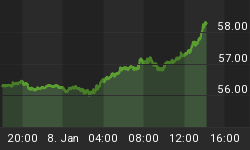Dollar consolidation set in last week at about the expected level, around 84 on the index. It got a bit higher, rising towards 84.80 early in the week, and dropped back intraday towards the end of the week, testing support back towards the 50-day moving average. Although it is expected to break higher again, it is not expected to get very far - not beyond the 85 - 85.50 area, where there is heavy resistance. This resistance arises from the trough that developed above this level early last year, and the falling 200-day moving average, both of which are expected to constrain further advance.


Should the dollar stage this limited advance, gold can be expected to back off towards its long-term trendline currently at about $420, and it MAY break down below this trendline. However, allowing a 3% margin for a trendline adjustment, and, given the fact that there is important support at the $400 level, we can afford to allow for the possibility that an adjusted trendline remains valid, as long as the price doesn't break below $400 on a closing basis.

Over the medium and long-term, the larger dollar downtrend is expected to reassert itself, and given that the oversold condition that existed last December has changed to an overbought condition, the downside potential is once again very considerable, which is clearly good news for gold. Should the larger dollar downtrend reassert itself, it can be expected to result in new lows - and new highs for gold. Note that it is also permissible for the dollar to push up out of its long-term downtrend line by a margin of up to 3% without invalidating it.

Conclusion: short-term dollar strength to the 85 - 85.50 area expected to be followed by renewed, and substantial, decline, resulting in limited short-term weakness in gold, that will be followed by it rising to new highs.
Given the recent weakness in gold, it should come as no surprise that the March - May period is traditionally a time of weakness for gold.
















